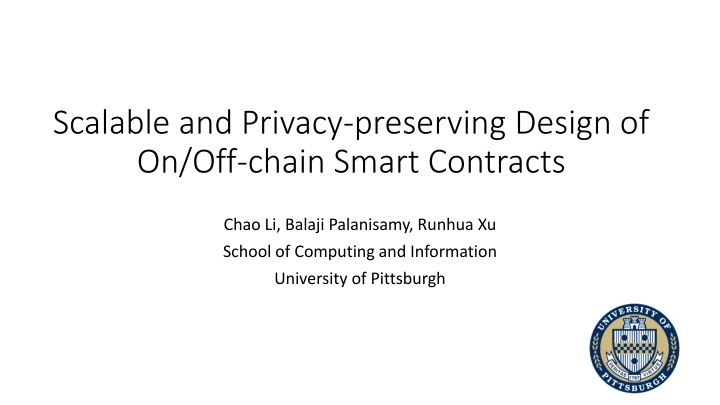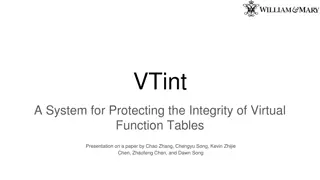
Privacy-Preserving Design of On/Off-Chain Smart Contracts
Explore the scalable and privacy-preserving design of on/off-chain smart contracts with insights on enforcement, implementation, and the evolution of blockchain technology in both industry and academia. Discover the significance of blockchain in different generations along with a deep dive into Ethereum's 2nd generation features and scalability solutions.
Download Presentation

Please find below an Image/Link to download the presentation.
The content on the website is provided AS IS for your information and personal use only. It may not be sold, licensed, or shared on other websites without obtaining consent from the author. If you encounter any issues during the download, it is possible that the publisher has removed the file from their server.
You are allowed to download the files provided on this website for personal or commercial use, subject to the condition that they are used lawfully. All files are the property of their respective owners.
The content on the website is provided AS IS for your information and personal use only. It may not be sold, licensed, or shared on other websites without obtaining consent from the author.
E N D
Presentation Transcript
Scalable and Privacy-preserving Design of On/Off-chain Smart Contracts Chao Li, Balaji Palanisamy, Runhua Xu School of Computing and Information University of Pittsburgh
Introduction Background On/off-chain smart contracts Enforcing off-chain contracts Implementation Conclusion
Blockchains in Industry 1st generation - value transfer Blockchain Market Size in Million USD 2500 2000 2nd generation - smart contracts 1500 1000 500 0 2016 2017 2018 2019 2020 2021 By 12/2018, there have been 2068 different cryptocurrencies listed in CoinMarketCap.com with a total market cap over 121 billion USD. Source: https://www.statista.com/statistics/647231/worldwide- blockchain-technology-market-size/
Blockchains in Academia Functionality Publications on Blockchain 5000 4500 Scalability Privacy 4000 3500 3000 2500 blockchain 2000 1500 1000 500 0 Security 2009 2010 2011 2012 2013 2014 2015 2016 2017 2018 Efficiency Source: https://app.dimensions.ai/analytics/publication/viz/overview- publications?search_text=blockchain Decentralization
Blockchains: the 1st generation new package Blockchain users form a P2P network enabling broadcast of messages In the network, users can issue transactions to transfer cryptocurrency Through consensus protocols, users are randomly selected to pack transactions as blocks and append new blocks to the blockchain.
Ethereum: the 2nd generation Alice wants her 1 Ether to be transferred to Bob after a specific time. Alice s transaction Alice s contract { from: Alice s address to: N/A data: bytecode of new contract value: 1 ether } ???????? ??? ???? ?????? { require(msg.sender == Bob s address); require(now > a specific time); msg.sender.transfer(1 ether); } Bob s transaction { from: Bob s address to: address of Alice s contract data: bytecode of function call value: 0 } Bob s function call ????4( ?? (??? ????()))
Ethereum: scalability 5,000,000 2,199,000 2,461,000 block 1,871,000 1,134,000 2,461,000 1,230,000 1,134,000 2,199,000 1,230,000 1,871,000 Transaction pool
Ethereum: scalability contract example { function A {} function B {} function C {} function D {} function E {} } } contract example { function A {} function C {} x3 x5 x8 x4 x5 50,000 800,000 12,290,000 30,000 1,100,000 390,000 reduce by 97% 700,000 function B {} function D {} function E {}
Ethereum: privacy contract example { function A {} function B {} function C {} function D {} function E {} private private public private public } function A {} function B {} function D {}
Our solution: On/off-chain smart contracts We broadly classify functions of smart contracts into two categories based on the computing resources spent for executing them and the sensitive information carried by them: 1. heavy/private functions involving high-cost calculation or sensitive information; 2. light/public functions involving none of these features.
Our solution: On/off-chain smart contracts a smart contract hybrid-on/off-chain all-on-chain f1: light/public f2: heavy/private participants f3: light/public miners f4: heavy/private miners f5: light/public f6: heavy/private state change example S1 S3 S4 S2 S5 f2 f4 f3 f5 all-on hybrid-on/off miners miners miners miners participants participants
Enforcing off-chain contracts Deploy & sign Split & generate Dispute & resolve Submit & challenge Split & generate on-chain contract light public Before any on-chain activity, the original contract is first split to two parts that package light/public functions and heavy/private functions, respectively. We need to pad each group of functions with a few extra functions prepared for a dispute. After padding, we have already generated an on-chain contract as well as another off-chain contract from the whole contract. original contract light public heavy private extra heavy private extra off-chain contract
Enforcing off-chain contracts Deploy & sign on-chain contract light public The on-chain contract can then be deployed by any participant to the blockchain. The off-chain contract needs to be converted into bytecode to be signed by all the participants. Each participant must obtain a copy of the off-chain contract with signatures from all the participants before any interaction with the deployed on-chain contract can take place. original contract light public heavy private extra heavy private bytecode signatures extra signed copy off-chain contract
Enforcing off-chain contracts Submit & challenge on-chain contract light public There will be a challenge period after a representative of the participants have submitted the result. During the challenge period, all other participants can challenge the result with the signed copy of the off-chain contract. If the representative is honest, there will be no need to challenge the submitted result. heavy private original contract light public heavy private extra heavy private bytecode signatures extra signed copy off-chain contract
Enforcing off-chain contracts Dispute & resolve on-chain contract light public verified instance heavy private To resolve a dispute, during the challenge period, any honest participant can submit the signed copy to the on-chain contract. An extra function padded to the on- chain contract during the split/generate stage will be called to verify the signed copy through signatures and create a verified on- chain instance. original contract light public heavy private create extra extra dispute heavy private bytecode signatures extra signed copy off-chain contract
Enforcing off-chain contracts Dispute & resolve on-chain contract light public verified instance heavy private A participant can then invoke the heavy/private functions within the verified instance to make them be executed by the miners. Then, an extra function padded to the off-chain contract will be invoked to send the true result back to the on-chain contract. Another extra function padded to the on-chain contract will receive the true result, enforce the dispute resolution and penalize the dishonest participant. original contract light public heavy private create extra extra enforce dispute heavy private bytecode signatures extra signed copy off-chain contract
Conclusion In this paper, we propose a general hybrid-on/off-chain execution model of smart contracts, which separates the heavy/private functions of a smart contract from the light/public ones to form an off-chain contract and enables the off-chain contract to be executed only by the interested participants. To handle disputes caused by any dishonest participants, we propose a mechanism that allows any honest participant to reveal a signed copy of the off-chain contract so that a verified instance can be created to make miners enforce the true execution result. Our implementation and evaluation of the proposed approach using an example smart contract demonstrate the effectiveness of the proposed approach of using on/off-chain contracts in Ethereum.
Thanks, Q&A 20











